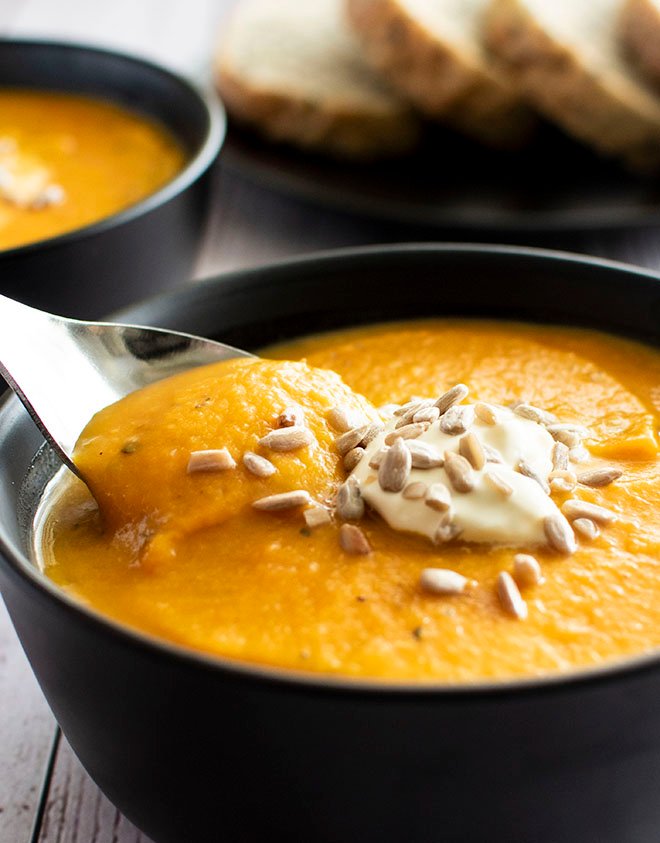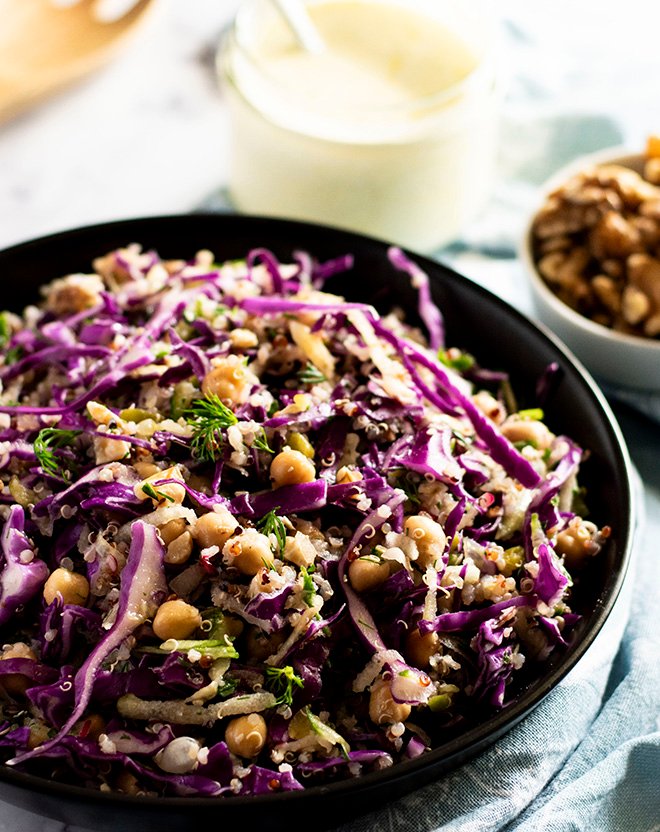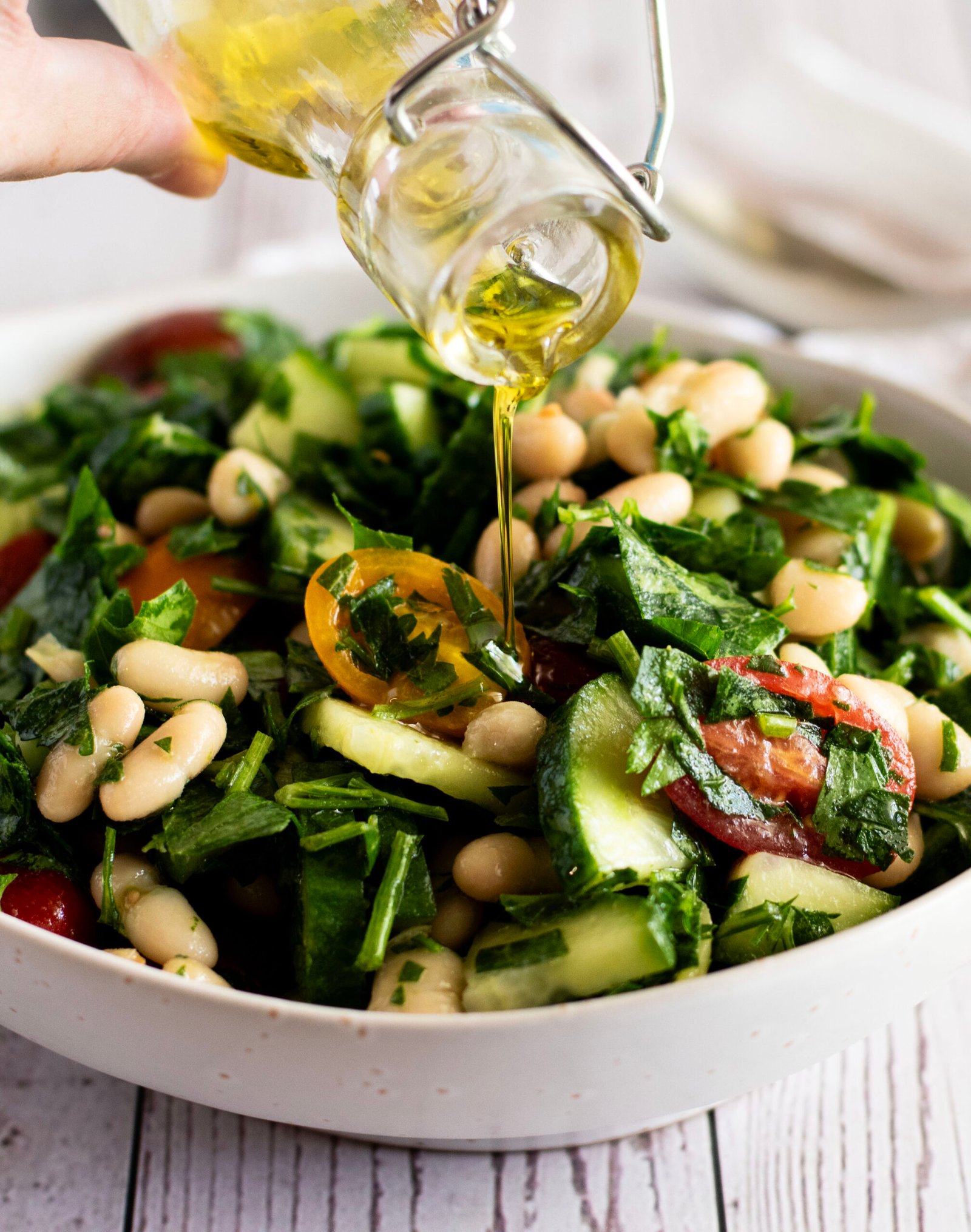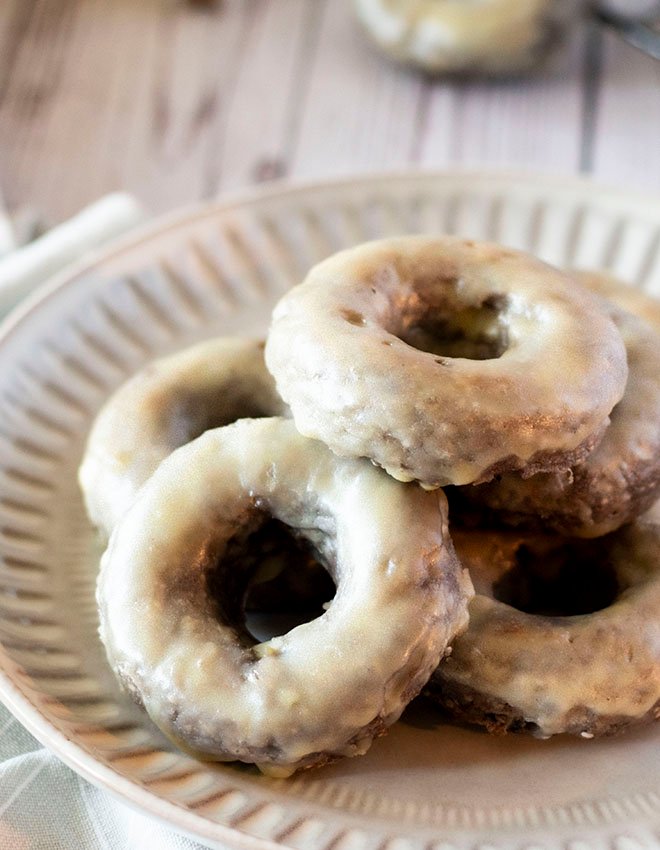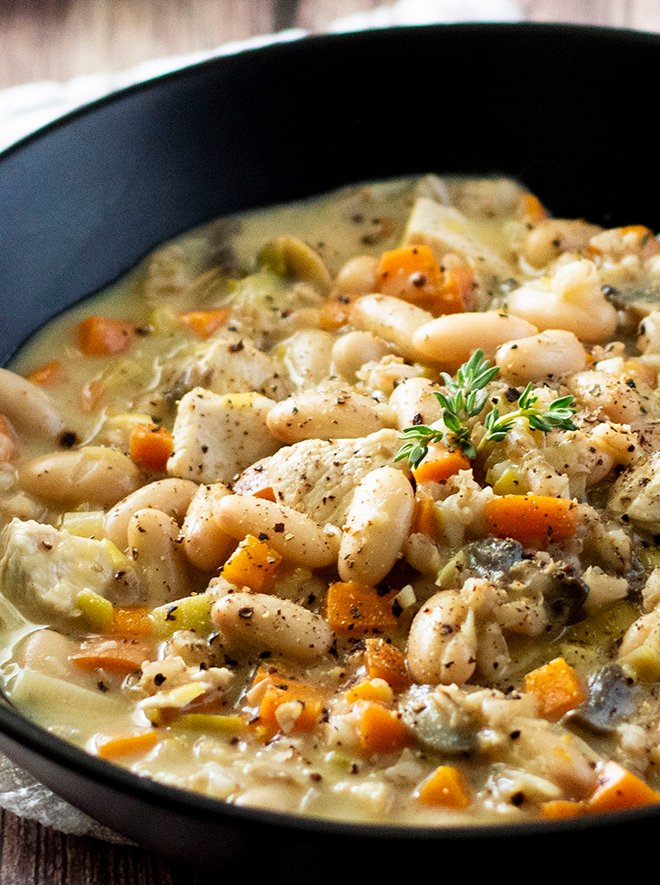Curry Cauliflower Potato Salad
This easy, creamy Curry Cauliflower Potato Salad is a healthier no-mayo twist on the classic side dish. Roasted cauliflower and potatoes, tossed in a curry, garlic and Greek yoghurt dressing with chickpeas and spring onions. Customise it to your tastes with egg and caramelised onions, or make it vegan.
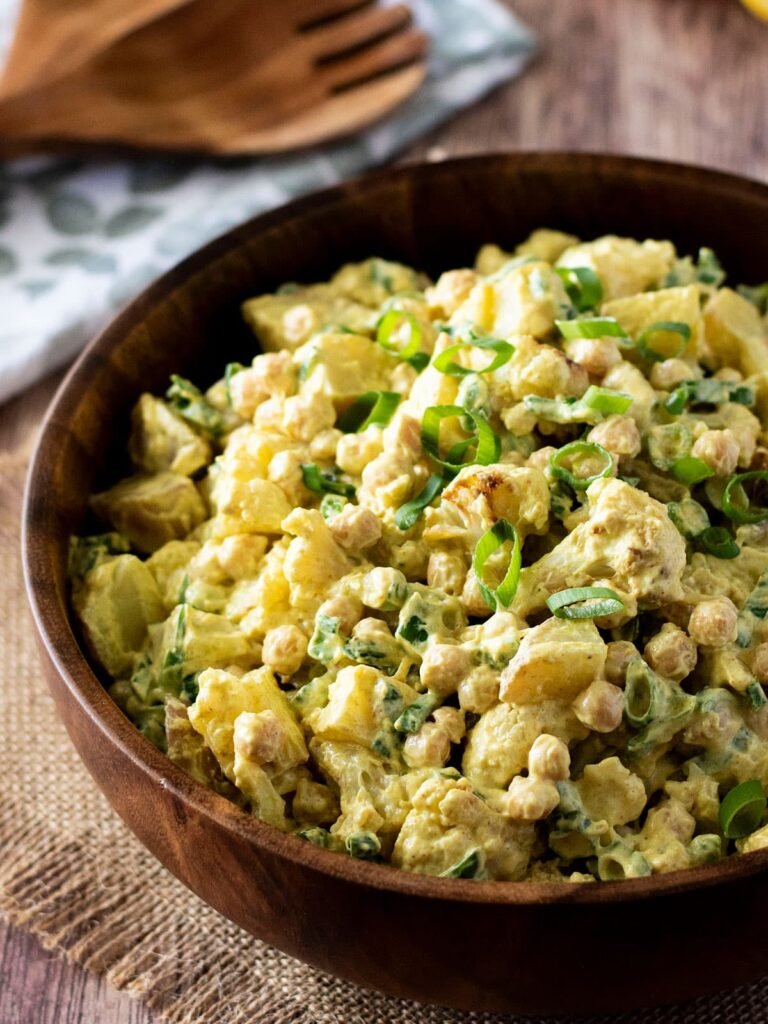
This Curry Cauliflower Potato Salad is the healthy side you want to take to your next BBQ! Made with roasted cauliflower and potatoes, this recipe is everything you love about potato salad – it’s creamy, but also healthy, tasty and super easy to make! Unlike regular potato and mock (or fauxtato) potato salads, this recipe gives you the best of both worlds!
I first made this recipe at a small family get-together back in May and received many compliments.
Why this is the best Cauliflower Potato Salad
- It is thick, creamy, and delivers BIG flavours!
- You can customise it to your tastes.
- It is quick and easy to make!
- Uses everyday ingredients that you’ll easily find in a supermarket.
- It is budget-friendly – costs only AUD$9 (~USD$6) to make.
- It is better for you than regular potato salad.
Classic potato salads can be high in fat (including saturated fat), sodium, and cholesterol and low in dietary fibre. However, with this Curry Cauliflower Potato Salad, you get much more dietary fibre and the probiotics of Greek yogurt while also being low in fat, cholesterol, and sodium! So you’re getting a potato salad that is both tasty and better for you for not much more than store-bought!

Benefits of Cauliflower
Cauliflowers are a wonderful nutritious vegetable that comes with many benefits, such as:
- The main nutrient in Cauliflower is vitamin C, which doubles as an antioxidant. Our bodies bodies also use vitamin C for immune system function and improves iron absorption.
- It has a good amount of vitamin K, which is used to make proteins required for blood clotting and keeping strong and healthy bones.
- Contains vitamin B6, which our bodies use for protein and fat metabolism, to make some neurotransmitters (the chemical messengers our brains use to communicate with the rest of our body), and red blood cells.
- They are a low GI food, meaning the carbohydrates are slowly digested and released into the bloodstream, which may help control blood glucose levels.
- They also have many different types of antioxidants, which have anti-inflammatory properties, and may help neutralise free radicals and reduce risk of certain chronic diseases.
Recipe suitability
This recipe contains a moderate amount of fibre, at 5.6g per serve, The dietary fibre, in addition to fermented foods (Greek yoghurt) make this a great side for supporting your gut health. It includes a moderate amount of protein, at 9.5g per serve. This Curry Cauliflower Potato Salad is low in fat (including saturated fat), cholesterol and sodium, which makes it a heart friendly dish. If you swap the potato for more cauliflower, it can also be diabetes friendly. This recipe is vegetarian and gluten free, but can be made vegan with a simple swap.
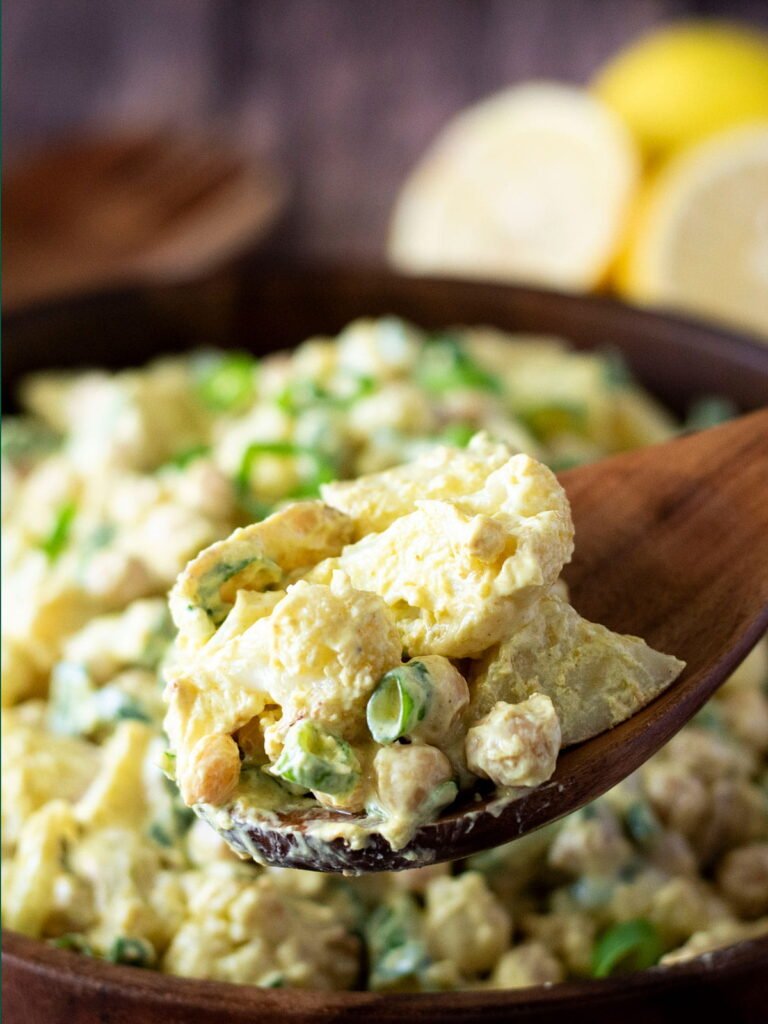
Ingredients for Cauliflower Potato Salad
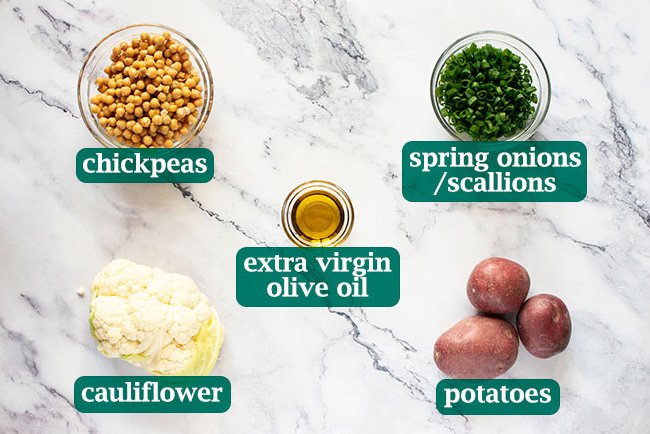
CAULIFLOWER POTATO SALAD
- Cauliflower – Scroll up to read about the benefits of cauliflower.
- Potatoes – Contain potassium, which is needed for body cell function, nerve transmission and muscle contractions. Potatoes can also be a great source of resistant starch, an undigested dietary fibre made by cooking and cooling starchy foods, which feeds our gut bacteria. Leave the skin on for extra dietary fibre and nutrients.
- Chickpeas – I used canned chickpeas for convenience, which can be high in excess sodium. Choose “reduced/no added salt” or the can with the lowest sodium per 100g. Chickpeas are a fantastic source of protein, which helps repair and strengthen muscle tissues. They are also loaded with dietary fibre, which may prevent constipation, helps us feel fuller for longer, and supports our gut health by fuelling our gut bacteria.
- Spring onion/scallions – For a bit of onion flavour.
- Extra virgin olive oil – For roasting the vegetables.
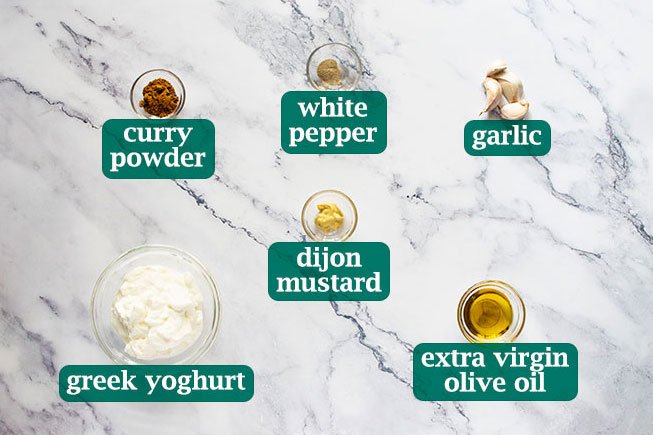
CREAMY CURRY YOGHURT DRESSING
- Greek yoghurt – Makes the creamy base for the dressing. Greek yoghurt is a fabulous substitute for mayonnaise/sour cream (and is just as creamy!), which is much lower in fat, sugar, sodium, and cholesterol and higher in protein. It is a probiotic, so you get the benefits for gut health. It is also rich in vitamin B2, which helps unlock energy from our food, and vitamin B12, which is used to make DNA for new body cells.
- Curry powder – Makes the dressing super tasty! Curry powder can be very high in sodium. I used ‘Clive of India’ curry powder (available at Coles and Woolworths), which is much lower in sodium than other available curry powders per 100g.
- Extra virgin olive oil – Thins out the dressing. Research suggests that regularly consuming extra virgin olive oil may be protective against strokes, heart disease and a range of other chronic diseases.
- Garlic – Roasted in the skins to develop a deep, slightly sweet flavour, and is super tasty! Garlic is rich in manganese, which is used for keeping strong bones and a healthy immune system. Research also hints that garlic has antiviral properties, may help reduce inflammation and oxidative stress, and risk factors for some chronic disease.
- Dijon mustard – Adds a tang and a touch of salt to the dressing. Dijon mustard is another food that tends to be relatively high in sodium. I used the ‘Your Condiment Co.’ Dijon mustard from Woolworths, which has the lowest sodium per 100g.
- Lemon zest – Adds a touch of lemon flavour to compliment the curry powder without being too acidic.
- White pepper – Blends more evenly into the yoghurt dressing than black pepper.
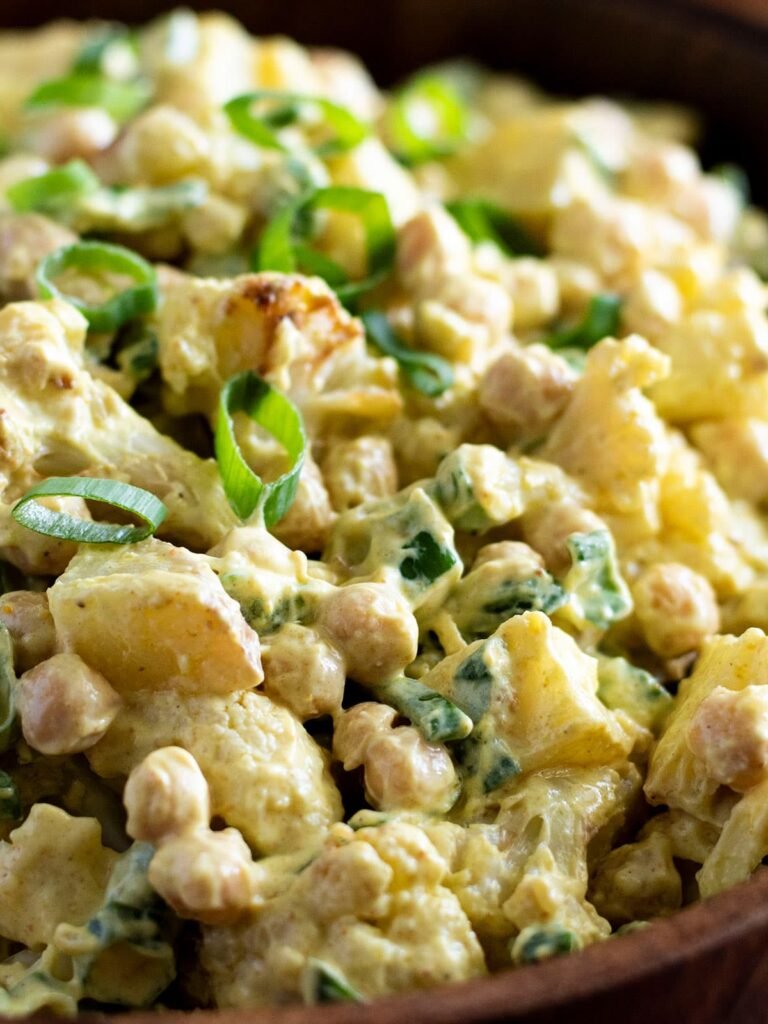
Which potatoes are best for potato salad?
Waxy potatoes are the best for this Curry Cauliflower Potato Salad. They hold their shape better after being cooked, and you don’t need to peel the skin, which means more dietary fibre and nutrients! Otherwise, all-purpose potatoes work too.
- Australia – I used ‘Red Royale’ potatoes. Or else, all-rounder potatoes such as Sebago (the dirt covered potatoes at all supermarkets), or Crème Royale potatoes (the white washed potatoes at supermarkets) will also work.
- US – Red potatoes. Otherwise, Russet or Yukon Gold potatoes for all-rounders.
- UK – Red potatoes, or Maris Piper and King Edward for all-rounders.
How to make Cauliflower Potato Salad
- Preheat oven to 200°C/390°F.
- Line a baking tray with baking paper. Arrange the cauliflower, potato, and garlic cloves (with the skin) on the tray and drizzle with extra virgin olive oil. Bake the vegetables for 20-25 minutes (stirring halfway) or until the potato pieces are soft in the centre. Set aside to cool slightly.

- Using a fork, fish the garlic cloves out from the baking dish. Add the garlic cloves to a small bowl and mash them with a fork into a paste. Add the curry powder, Greek yoghurt, extra virgin olive oil, Dijon mustard, lemon zest and white pepper. Mix well until combined and the dressing is thick and creamy.

- Add the roasted cauliflower and potatoes into a large bowl with the chickpeas and spring onion. Pour the dressing into the bowl and toss until the vegetables are coated.

- Serve while warm as a side dish or store in the fridge until ready to serve. Enjoy!
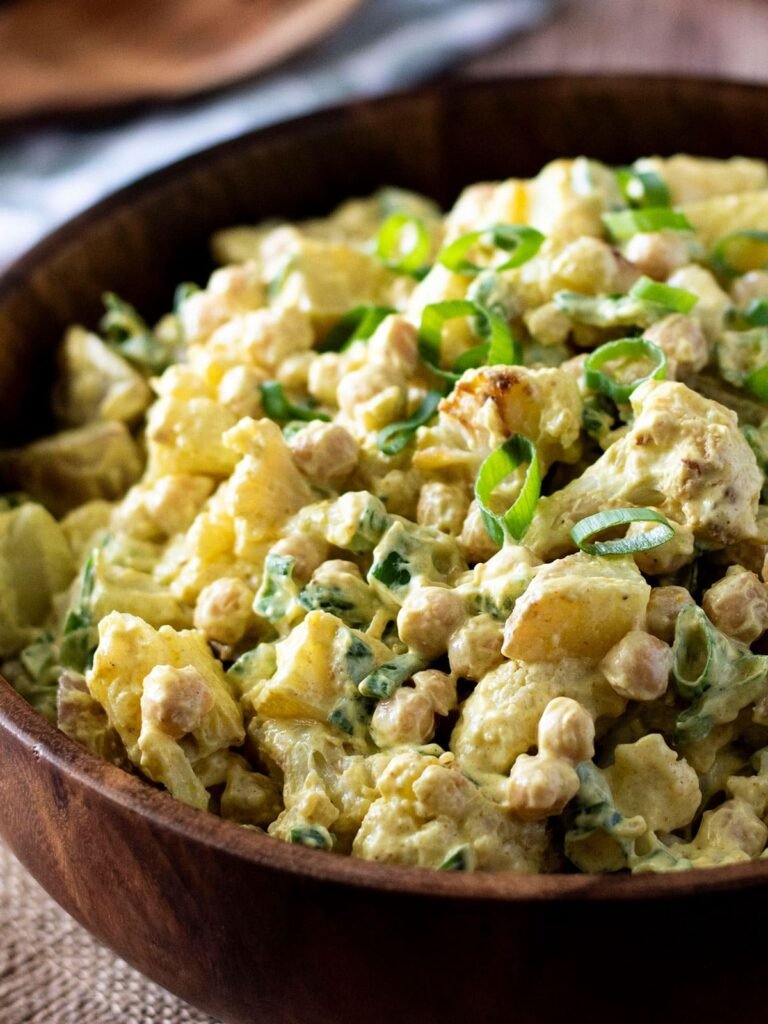
Other ways to make Cauliflower Potato Salad
AIR FRYER
- Preheat the air fryer to 180°C / 350°F if needed.
- Add the cauliflower, potato, and garlic cloves (with the skin) to a bowl and drizzle with extra virgin olive oil. Transfer the vegetables to the air fryer basket or tray. Cook the cauliflower and potato for 15-18 minutes or until the potato pieces are soft in the centre. Set aside to cool slightly.
- Follow the recipe above from step 3 onwards.
MICROWAVE
- Add the cauliflower and potato into a microwave-safe in a single layer container and pour in just enough water to cover the bottom. Heat the vegetables in the microwave on high for 4-5 minutes or until the cauliflower and potato are soft when pierced with a fork. (Note: Your cooking time may be longer if your container is not very wide, or the vegetables are stacked on top of each other).
- While microwaving the vegetables, heat 1 teaspoon of extra virgin olive oil in a small saucepan over medium-high heat. Mince the garlic cloves and add them to the small saucepan. Cook for 1-2 minutes or until the fragrant, then remove from the heat.
- Drain the cauliflower and potato well and place them on a plate covered with paper towel to dry and cool slightly.
- Follow the recipe above from step 3 onwards but include the sauteed garlic in the dressing.
STOVE TOP
Follow the instructions for microwaving, but use a steamer basket over a pot of boiling water (do not submerge in the water).
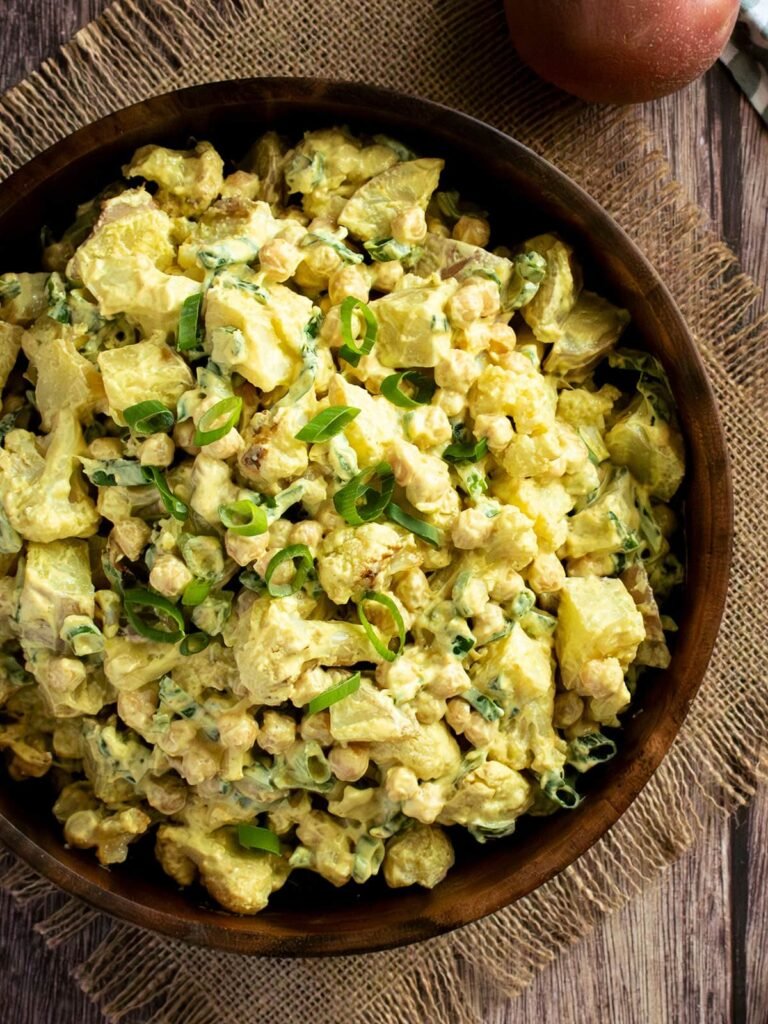
Storage
This salad will last in the fridge in an airtight container for 3 days.
Want the salad warm? Stick it in the microwave for 30 seconds – 1 minute!
Can you make it ahead of time?
Absolutely! Just prepare the vegetables and curry dressing and store them separately. When you’re ready to serve, add the dressing to the cauliflower potato salad and toss well to mix!
Can you use frozen cauliflower?
While you can use frozen cauliflower, it will be very soft and mushy, which may affect the salad’s overall texture. I recommend cooking the frozen cauliflower in the microwave (separate from the potatoes) for 2-3 minutes and then allow to dry and cool slightly on some paper towel.
Serve this Cauliflower Potato Salad with
This salad would be a perfect side for:
- Juicy portobello mushroom burgers
- Tender baked tandoori salmon
- Whole roast chicken
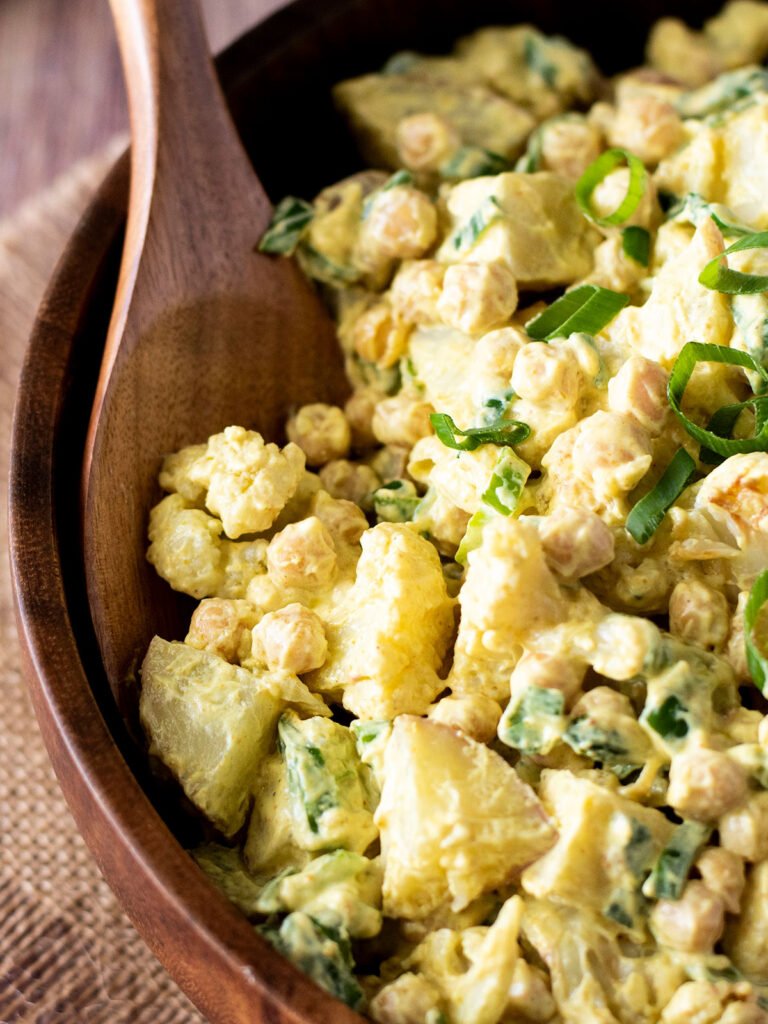
Substitutes & variations
- Hard-boiled eggs – Are great for adding extra texture and creaminess, but also adds protein (which is good for big eaters, as the salad will be more filling)!
- Onion – Either fresh red onion or caremlised brown/yellow onion would work.
- Celery – Adds a crunch element.
- Dill pickles – For a bit of tang and crunch. I do not recommend using pickle juice, as it contains a lot of excess sodium and sugar.
- Slivered almonds – Add a crunch and nuttiness.
- Bacon – Use short-cut bacon/bacon medallions, which is much leaner than other cuts. Remove any visible fat (helps to remove excess saturated fat).
- Chives – In place of, or alongside spring onions for extra flavour.
Other dietary substitutes
- Diabetes friendly – Turn this recipe into a mock or faux potato salad and swap out the potato for extra cauliflower. This will reduce the amount of carbohydrates and will make the salad completely low GI.
- Garlic free – Leave the garlic out or substitute with 2-3 tsp of garlic infused olive oil.
- Gluten Free – Double check to ensure the Dijon mustard and curry powder are certified gluten free, as they may have hidden gluten-containing ingredients or may have been exposed to gluten during manufacturing.
- Vegan – Swap out the Greek yoghurt for a creamy plant-based unflavoured yoghurt (preferably calcium-fortified).
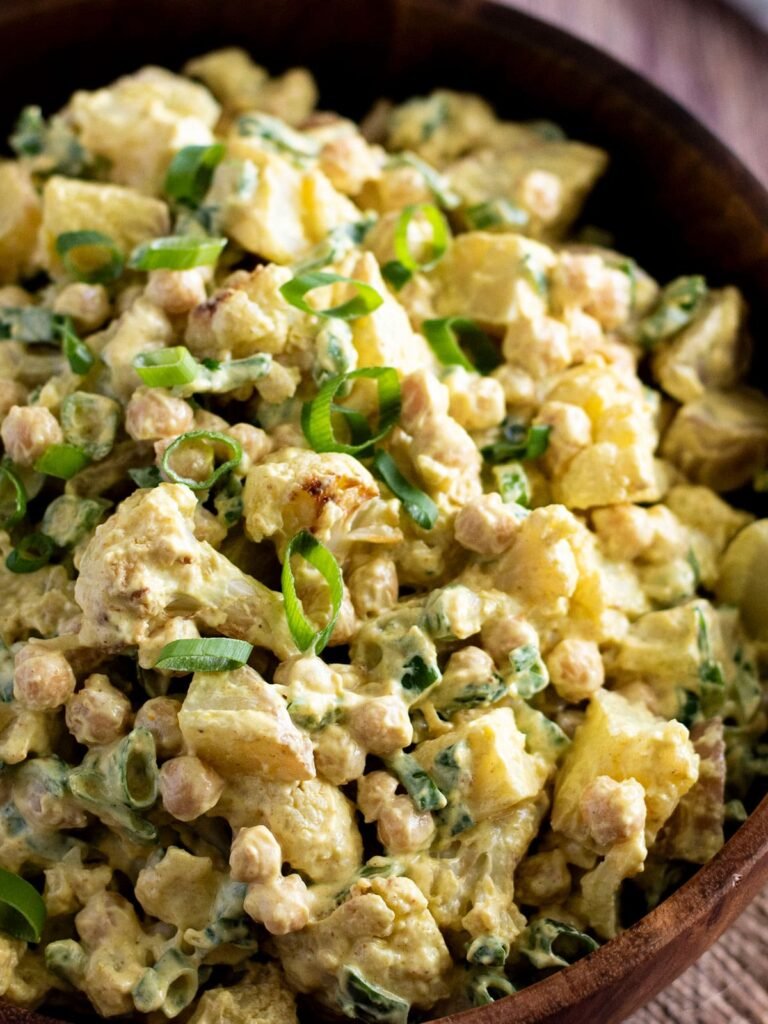
Tips
The colour and heat level of curry powders may vary between brands – so I highly recommend adding a small amount at a time and tasting if you plan on serving this recipe to young children or people with poor chilli tolerance.
Cut the cauliflower & potato pieces into relatively equal sizes so they cook in the same amount of time.
Always rinse your chickpeas after draining; this helps remove the brine (which may contain excess sodium and sugar).
Hungry for more?
Don’t forget to subscribe to my newsletter and follow along on Facebook, Instagram and Pinterest for all the latest updates!
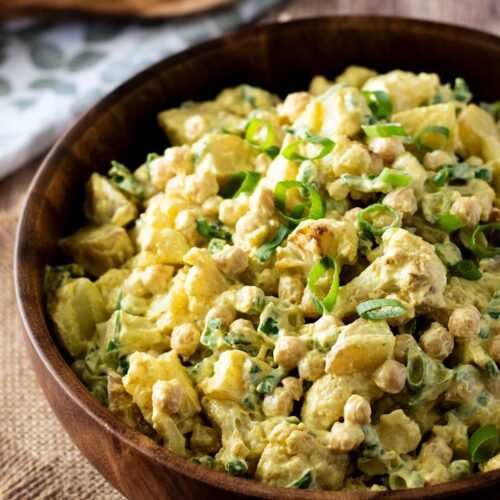
Tap or hover to scale
Ingredients
Cauliflower Potato Salad
- 1/2 medium (350g / 12.3 oz) cauliflower, cut into bite-sized florets
- 2 medium (350g / 12.3 oz) potatoes, cut into bite-sized pieces
- 1 tbsp extra virgin olive oil
- 1 400g / 14.1 oz can of chickpeas, drained and rinsed
- 1 cup spring onion / scallions, thinly sliced
Curry Yoghurt Dressing
- 5 garlic cloves
- 2/3 cup greek yoghurt, low fat
- 1 3/4 tsp curry powder, NOT KEENS!!! (Note 3)
- 2 tsp extra virgin olive oil
- 1 1/2 tsp dijon mustard
- 1 tsp lemon zest
- 2 dashes white pepper
Instructions
- Pre heat oven to 200°C/390°F.
- Line a baking tray with baking paper. Arrange the cauliflower, potato, and garlic cloves (with the skin) on the tray and drizzle with extra virgin olive oil. Bake the vegetables for 20-25 minutes (stirring halfway) or until the potato pieces are soft in the centre. Set aside to cool slightly.
- Using a fork, fish the garlic cloves out from the baking dish. Remove the skin from the garlic cloves. An easy way to remove the skins is by squeezing the pointy end of the garlic clove between your finger and thumb, then squeeze the rest out with your other hand. Add the caramelised garlic to a bowl and mash them with a fork into a paste. Add the curry powder, Greek yoghurt, extra virgin olive oil, Dijon mustard, lemon zest and white pepper. Mix well until combined and the dressing is thick and creamy.
- Add the roasted cauliflower and potatoes into a large bowl with the chickpeas and spring onion/scallions. Pour the dressing into the bowl and toss until the vegetables are coated.
- Serve while warm as a side dish or store in the fridge until ready to serve. Enjoy!
Notes
- Health benefits – Details regarding the benefits of cauliflower and other ingredients in this recipe are in the post above.
- Other cooking methods & instructions with photos – Detailed in the post above.
- Curry powder – Do not use Keens, it will be too salty. I used ‘Clive of India’ curry powder (available at Coles and Woolworths), which is much lower in sodium. The colour and heat level of curry powders may vary between brands – so I highly recommend adding a small amount at a time and tasting if you plan on serving this recipe to young children or people with poor chilli tolerance.
- Other additives
- Hard-boiled eggs – Are great for adding extra texture and creaminess, but also adds protein (which is good for big eaters, as the salad will be more filling)!
- Onion – Either fresh red onion or cooked brown onion would work.
- Celery – Adds a crunch element.
- Dill pickles – For a bit of tang and crunch. I do not recommend using pickle juice, as it contains a lot of excess sodium and sugar.
- Slivered almonds – Add a crunch and nuttiness.
- Bacon – Use short-cut bacon/bacon medallions, which is much leaner than other cuts. Remove any visible fat (helps to remove excess saturated fat).
- Chives – In place of, or alongside spring onions for extra flavour.
- Storage – Will last in the fridge in an airtight container for 3 days. If you want the salad warm, stick it in the microwave for 30 seconds – 1 minute.
- Diabetes friendly – Turn this recipe into a mock or faux potato salad and swap out the potato for extra cauliflower. This will reduce the amount of carbohydrates and will make the salad completely low GI.
- Garlic free – Leave the garlic out or substitute with 2-3 tsp of garlic infused olive oil.
- Gluten free – Double check to ensure the Dijon mustard and curry powder are certified gluten free, as they may have hidden gluten-containing ingredients or may have been exposed to gluten during manufacturing.
- Vegan – Swap out the Greek yoghurt for a creamy plant-based unflavoured yoghurt (preferably calcium-fortified).
- Nutrition – Calculated per serve, assuming 6 serves with no other foods.


